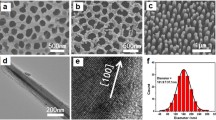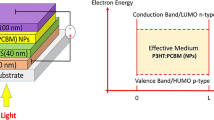Abstract
This paper presents recent progress in computational modeling on blend morphology of silicon nanowires (SiNWs) dispersed in a conjugated polymer poly(3-hexylthiophene) P3HT hybrid solar cells. Mixtures of poly-(3-hexyl-thiophene) as electron-donor and silicon nanowires as electron-acceptor materials have been widely investigated. In this work, we extracted five parameters such as the ideality factor, the saturation current, the photocurrent, the series and the shunt resistances from measured current–voltage characteristics. These parameters are used in the simulation study to obtain the theoretical curves by using the Newton-Raphson method developed in MATLAB code. A good agreement is obtained between theoretical model and experimental measurement of electrical characteristics. Taking the advantage of the simulation study, we determined the solar cell parameters to study the effect of SiNWs concentration, the type of solvent used for film fabrication and the thickness of photoactive layer in the performance of ITO/PEDOT:PSS/P3HT:SiNWs/Al hybrid solar cells in target to achieve the optimal condition: 15% of SiNWs dispersed within P3HT matrix fabricated from THF solution and 115 nm thickness photoactive layer with fill factor FF and efficiency η equal to 48% and 0.08%, respectively.
Similar content being viewed by others
Data Availability
The authors confirm that the data supporting the findings of this study are available within the article.
References
Chegaar M, Ouennoughi Z, Guechi F (2004) Extracting dc parameters of solar cells under illumination. Vacuum 75:367–372
Kennerud KL (1969) Analysis of performance degradation in CdS solar cells. IEEE Trans Aerosp Electron Syst AES 5:912–917
Lun S, Du C, Guo T, Wang S, Sang J, Li J (2013) A new explicit I-V model of a solar cell based on Taylo’s series expansion. Sol Energy 94:221–232
Cabestany J, Castaiier L (1983) Evaluation of solar cell parameters by nonlinear algorithms. J Phys D Appl Phys 16:2547–2558
Mirjalili S, Gandomi AH, Mirjalili SZ, Saremi S, Faris H, Mirjalili SM (2017) Salp swarm algorithm: a bio-inspired optimizer for engineering design problems. Adv Eng Softw 114:163–191
Jain A, Kapoor A (2005) A new method to determine the diode ideality factor of real solar cell using Lambert W-function. Solar Energy Mater Solar Cells 85(3):391–396
Easwarakhanthan T, Bottin J, Bouhouch I, Boutrit C (1986) Nonlinear minimization algorithm for determining the solar cell parameter with microcomputers. Int J Sol Energy 4:1–12
Rahmani M, Meftah A (2020) Electrical characterisation of Ag/poly(3-hexylthiophene)/silicon nanowires Schottky diode. J Mater Sci Mater Electron 31:16352–16359
Saidi H, Aloui W, Bouazizi A (2018) Bias voltage effect on the dielectric properties of organic–inorganic blend SiNWs elaborated via metal assisted chemical etching. J Mater Sci Mater Electron 29:18051–18058
Saidi H, Hidouri T, Fraj I, Saidi F, Bouazizi A (2015) Effect of etching time and illumination on optical properties of SiNWs elaborated by Metal Assisted Chemical Etching (MACE) for organic photovoltaic applications. Superlattice Microst 85:925–930
Saidi H, Walida A, Bouazizia A, Herrerob B, Saidi F (2017) Effects of silicon nanowires (SiNWs) contents on the optical and dielectric properties of poly(3-hexylthiophene):SiNWs nanocomposites. J Phys Chem solids 107:1–6
Davenas J, Ben Dkhil S, Cornu D (2012). Energy Procedia 31:136–143
Dkhil SB, Ebdelli R, Dachraoui W, Faltakh H, Bourguiga R, Davenas J (2014) Improved photovoltaic performance of hybrid solar cells based on silicon nanowire and P3HT. Synth Met 192:74–81
Singh J, Narayan MR (2014) Optimizing the design of flexible PTB7:PC71BM bulk-heterojunction and P3HT: SiNW hybrid organic solar cells. Nanosci Technol 1:1–8
Rodrigues R, Ferreira Q, Mendonc MA, Morgado J (2014) Template role of polyhexylthiophene nanowires on efficient bilayer photovoltaic cells. Synth Met 190:72–78
Chehata N, Ltaief A, Beyou E, Ilahi B, Salem B, Baron T, Gentile P, Maaref H, Bouazizi A (2015) Functionalized silicon nanowires/conjugated polymer hybrid solar cells: optical, electrical and morphological characterizations. J Lumin 168:315–324
Braik M, Dridi C, Rybak A, Davenas J, Cornu D (2014) Correlation between nanostructural,optical, and photoelectrical properties of P3HT:SiNW nanocomposites for solar-cell application. Phys Status Solidi A 211(3):670–676
Azizi S, Braik M, Dridi C, Ben Ouada H, Ryback A, Davenas J (2012) Study of charge transport in P3HT:SiNW-based photovoltaic devices. Appl Phys A 108:99–106
Khan F, Al-Ahmed A, Al-Sulaiman F (2021) Critical analysis of the limitations and validity of the assumptions with the analytical methods commonly used to determine the photovoltaic cell parameters. Renew Sustain Energy Rev 140:110753
Chen L, Pan X, Zheng D, Gao Y, Jiang X, Xu M, Chen H (2010) Hybrid solar cells based on P3HT and Si@MWCNT nanocomposite. Nanotechnology. 21:345201
Magubane SS et al Materials Today: Proceedings (in press)
Acknowledgments
The authors wish to thank Dr. Sadok ben Dkhil for the support rendered to this work.
Author information
Authors and Affiliations
Contributions
Dr. Hana Faltakh designed, analyzed the results, prepared figures and wrote the manuscript. Dr. Ramzi Bourguiga supervised the research. Dr. Amira ben Ahmed discussed the results.
Corresponding author
Ethics declarations
Not applicable.
Consent to Participate
Not applicable.
Consent for Publication
All the authors declare their consent for publication of the article on acceptance.
Conflict of Interest
The authors declare that there is no conflict of interest regarding the publication of this paper.
Additional information
Publisher’s Note
Springer Nature remains neutral with regard to jurisdictional claims in published maps and institutional affiliations.
Rights and permissions
About this article
Cite this article
Faltakh, H., Bourguiga, R. & Ahmed, A.B. Hybrid Solar Cells Based in Silicon Nanowires: Electronic Simulation and Optimization. Silicon 13, 4201–4213 (2021). https://doi.org/10.1007/s12633-021-01276-0
Received:
Accepted:
Published:
Issue Date:
DOI: https://doi.org/10.1007/s12633-021-01276-0




